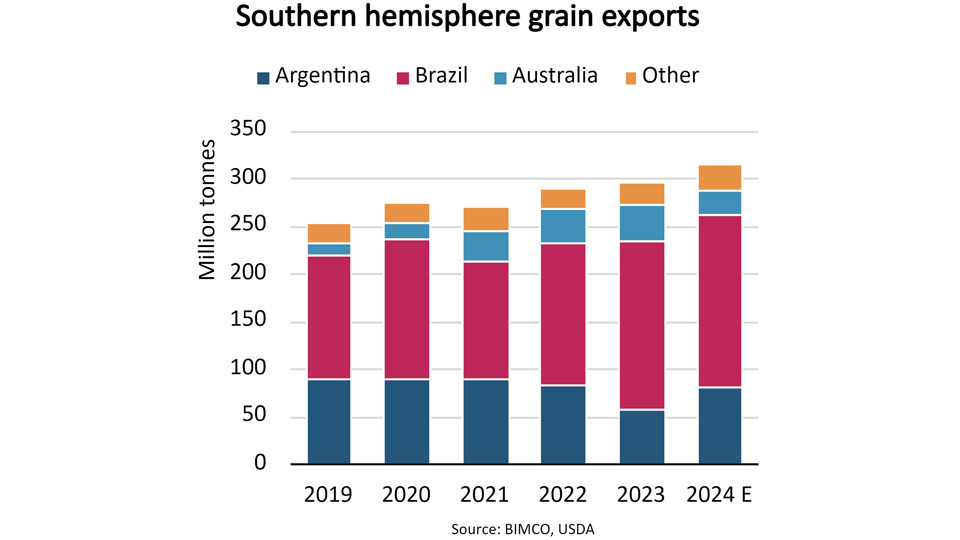Argentina’s grain exports could jump 40% due to favourable weather
El Niño has brought improved weather conditions for Argentina’s grain crops. The wheat harvest is nearly complete and estimated to be 20% larger than a year ago. Meanwhile, the favourable conditions continue to support the growing maize and soybean crops. Though exports should increase across the board, maize is expected to see the biggest boost. A 71% increase in maize exports is expected, equivalent to an additional 17 million tonnes in 2024.
In 2024, grain exports from the southern hemisphere could increase by 5-6%, driven by Argentina’s large harvests. This, paired with the above average sailing distances for Argentinian grain shipments, would support demand for ships in the panamax and supramax segments.
While El Niño has been favourable for Argentina, it has led to a weaker wheat harvest in Australia and mixed conditions in Brazil. In Brazil, the forecasts for maize and soybean harvests have been gradually revised downwards. Nonetheless, if conditions do not deteriorate further, Brazilian grain exports should remain stable in 2024 due to high soybean and maize inventories.
The National Oceanic and Atmospheric Administration estimates there is a 60% chance that El Niño will end during April-June 2024. Under neutral conditions, weather conditions in Argentina are less favourable to grain harvests. As such, yields could be lower during next year’s harvests.
Argentina’s new president Javier Milei intends to increase export tariffs for maize and wheat from 12% to 15%. This is part of a set of emergency measures for the Argentinian economy to be discussed during the first quarter of 2024. Since most of this year’s grain has already been planted, this measure is unlikely to have a significant short-term effect on supply.
In the medium term, higher tariffs could lead to lower grain exports as farmers might allocate less planting area to these crops. However, if approved, many expect this measure to be temporary and that Milei will pursue export friendly policies in the long run. In turn, this would allow Argentina’s grain exports to rebound to levels seen during 2019-2022.
Feedback or a question about this information?
BIMCO's Shipping number of the week
- Iron ore shipments up 3.8% despite weak Chinese demand
- COVID pandemic wiped 24.6 million TEU off container market growth
- EU tanker import tonne mile demand up 12% as ships avoid Red Sea area
- Demand shocks drive ship recycling to lowest level in 20 years
- 13% of world seaborne trade under attack from Houthis and Somali pirates
ELSEWHERE ON BIMCO
Contracts & Clauses
All of BIMCO's most widely used contracts and clauses as well as advice on managing charters and business partners.
Learn about your cargo
For general guidance and information on cargo-related queries.
BIMCO Publications
Want to buy or download a BIMCO publication? Use the link to get access to the ballast water management guide, the ship master’s security manual and many other publications.




